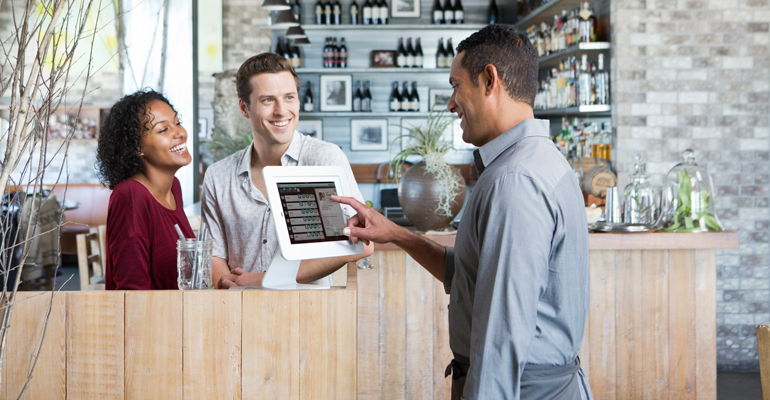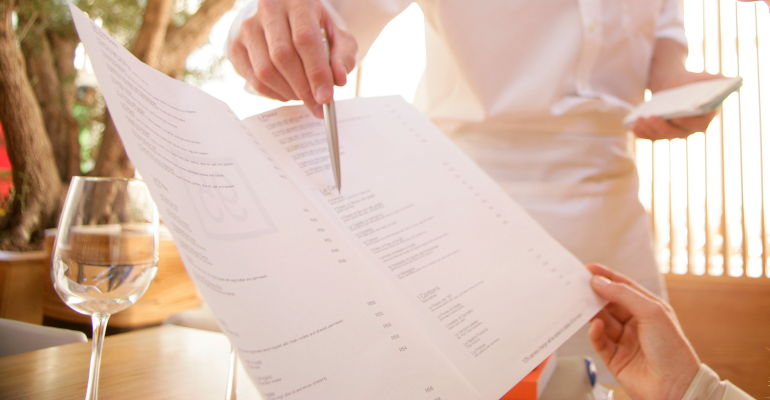As restaurant operators continue to look for an edge in the hyper competitive, little-to-no-traffic-growth market, data is becoming a tool for determining not only what’s on the menu, but how that menu is designed.
Restaurant technology players Cake, Toast and Upserve are helping restaurant operators mine and analyze customer ordering data, as well as leverage human psychology, to strategically develop menus that maximize customer satisfaction and positively impact the bottom line.
“The menu no longer lives in just the restaurant. It lives in social media, online, in customers’ phones,” said Jesse Noyes, senior director of marketing for Upserve, a Providence, R.I.-based restaurant platform management firm. “Your menu has the ability to go beyond the four walls, so it needs to be intentional.”
Menu design, a division of menu engineering focused on the visual science and appeal of a restaurant’s menu, has become increasingly important in recent years, said officials at Cake, a restaurant management/point-of-sale system provider from Houston-based Sysco.
Independent restaurateurs, in particularly, are starting to realize more and more the importance of a menu as a marketing vehicle versus being just a food list, said the Cake team.
Indeed, more restaurant operators are using the tools provided by Boston-based Toast, a cloud-based software company that provides restaurant management and POS systems, said Allie Tetreault, Toast content marketing manager.
Officials from Cake, Toast and Upserve shared their top tips for designing a sales-driving menu:
1. Keep it small. More choice doesn’t always lead to more orders.
Restaurant owners should examine their menus to determine the ideal number of items in order to stand out among competitors, said officials at Cake. Recent Cake data shows a correlation between the number of Yelp stars and the number of menu items, with higher Yelp ratings for restaurants with smaller menus.
“[Having] too many menu items is a common design mistake,” said Toast’s Tetreault. “Having a menu that’s extremely long means that guests will spend more time deciding what they want, increasing your table turn time and decreasing the actual amount of guests you can serve.”
2. Get organized.
Your menu is more than just an alphabetical list of food or a guide to how you want diners to eat, it’s the front line for driving sales.
“Eighty percent of sales [are] coming from 16 percent of menu items,” said Upserve’s Noyes. “Restaurants need to think about what dishes they really want customers to pay attention to.”
One easy way to find out what’s working and what’s not on our menu is to just ask diners.
“Is it confusing to read? What was easy to find, and what was hard to find? Do some user testing with your loyalty members and help them decide the direction of your next menu redesign,” advised Toast’s Tetreault.

3. Make profitable dishes pop.
Research shows that people tend to look first at the top right-hand corner of a menu first, so placing high-margin items or specials there is a smart move.
“Find out what your top 10 most-popular menu items (units sold) are as well as your top 10 most profitable (food cost percentage). When you find out your ‘stars’ in both areas, move them to the top right of the menu where guests’ eyes automatically gravitate toward,” said Tetreault. “You’ll immediately start selling more of your most-profitable and popular item, increasing sales.”
Or use design to draw attention to select items. For example, drawing a box around an item or adding photos. Research shows that adding a photo alongside an item can increase its sales up to three times as much as items without photos, noted Tetreault.
4. Get descriptive.
The more details you provide, the more a dish is likely to sell.
According to Upserve research, longer, more evocative descriptions increase sales as much as 25 percent.
“It has real impact,” said Noyes. “You can drive them where you want.”
5. Ditch the dollar signs.
They may be little symbols, but dollar signs can have a negative impact on people’s ordering decisions.
“Most guests are price-averse, so the more you can de-emphasize price, the better,” said Tetreault.
6. Use color wisely.
The colors, look and feel and tone of the menu should match the restaurant’s brand identity.
Your menu is an opportunity to market and extend to patrons what the restaurant is all about, according to the Cake team.
Purchasing decisions have long been influenced by these kinds of marketing tactics, but the advent of new technologies is enabling restaurants to more easily capture and understand their data and use it to their benefit.
“People are easily motivated by price, color, position, description. All these things are how we’ve bought things forever,” said Noyes. “We now have more data than ever to understand that.”





